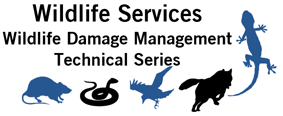United States Department of Agriculture: Animal and Plant Health Inspection Service

Wildlife Damage Management Technical Series
Date of this Version
5-2021
Document Type
Article
Citation
Gese, E.M., J.P. Hart, and P.A. Terletzy. 2021. Gray Wolves. Wildlife Damage Management Technical Series. USDA, APHIS, WS National Wildlife Research Center. Fort Collins, Colorado. 29p.
Abstract
Wolf conflicts are primarily related to predation on livestock, pets and other domestic animals, as well as their direct and indirect impacts on native ungulates (i.e., big game). Economic losses vary widely with some livestock producers facing high levels of depredation in some areas. This publication focuses on wolf ecology, damage, and management, particularly as it relates to wolf depredation on livestock and other conflicts with people.
Wolves and people share the same environments more than people realize. In the U.S., wolves are not confined to wilderness areas. Though curious, wolves generally fear people and rarely pose a threat to human safety. Wolf attacks on people are, and always have been, very rare compared to other wildlife species. However, there have been several cases of human injuries and a few deaths due to wolves in North America over the past 100 years. The main factors contributing to these incidents were habituation to people, rabies infections, conditioning to human foods, and the presence of domestic dogs. It is unusual for wild wolves to associate or interact with people, linger near buildings, livestock, or domestic dogs, but it does occur especially in areas of high wolf densities in and around rural communities. This type of behavior may be more prevalent in areas where wolves are not legally harvested. This “bold” behavior is more typical of a habituated or food- conditioned animal, a released captive wolf, or a released wolf-dog hybrid.
The scale and scope of wolf depredation on livestock depends on local wolf density; numbers and kinds of livestock; livestock husbandry practices; availability and vulnerability of alternative prey; human density; road density; severity of winters; and local hunting pressure. In many instances, wolves live around livestock without causing damage or only occasional damage. Wolf pack size has been shown to increase the likelihood of depredations on domestic animals, with larger packs more likely to cause damage. Most losses occur between April and October when livestock are on summer pastures or grazing allotments. Cattle, especially calves, are the most common livestock killed by wolves. When wolves kill sheep or domestic poultry, often multiple individuals are killed or injured.
As of 2019, stable wolf populations exist in many regions in the U.S., including Alaska, Minnesota, Wisconsin, Michigan, Wyoming, Montana, and Idaho, with growing populations in parts of Oregon and Washington (Figures 19, 20). Wolves have recently been documented in northern California and northwestern Colorado. A small population of introduced Mexican wolves exists in Arizona and New Mexico, and a small population of red wolves exists in eastern North Carolina. Both the Mexican and red wolf populations are considered more vulnerable to extinction than other North American wolf populations.
Included in
Behavior and Ethology Commons, Biodiversity Commons, Other Animal Sciences Commons, Other Ecology and Evolutionary Biology Commons, Population Biology Commons, Terrestrial and Aquatic Ecology Commons


Comments
U.S. government work